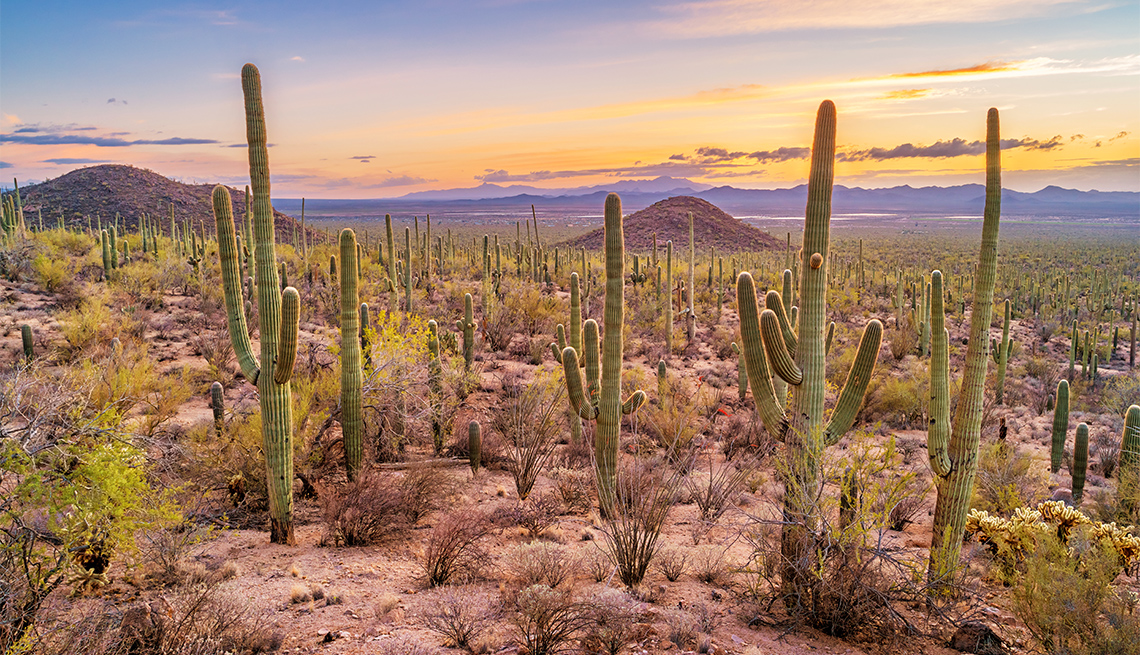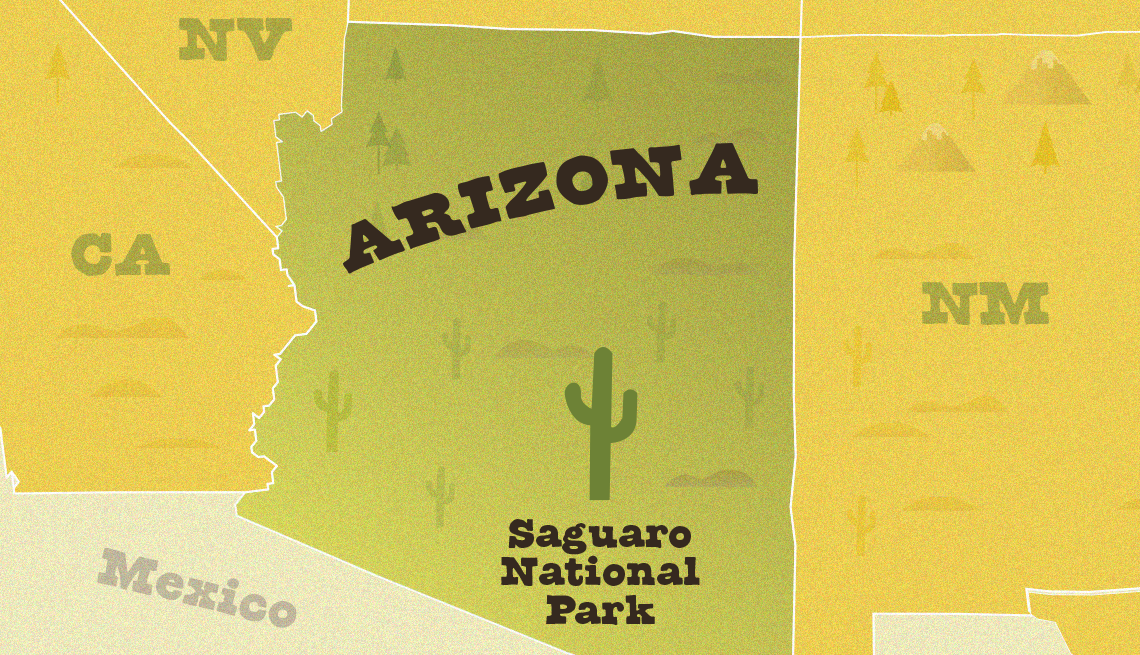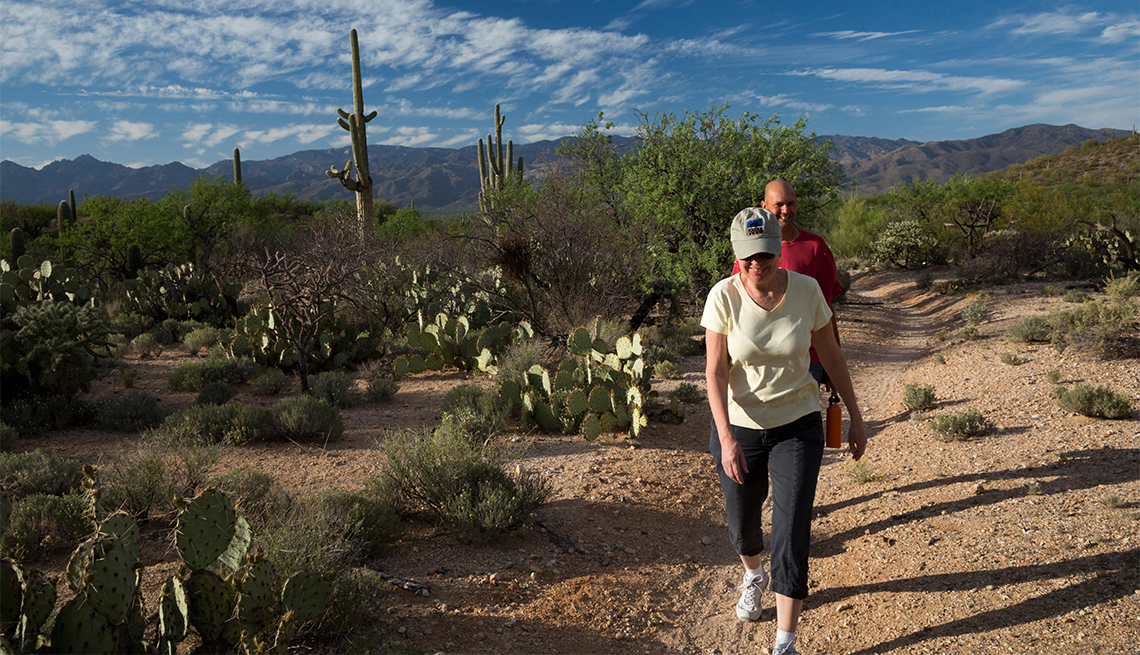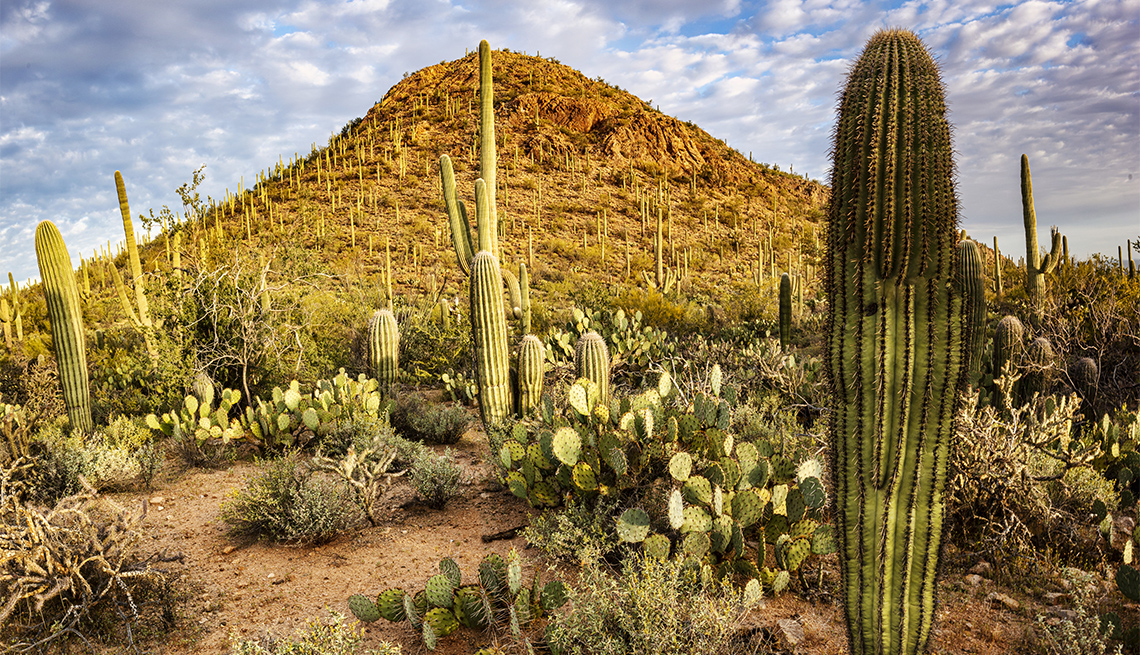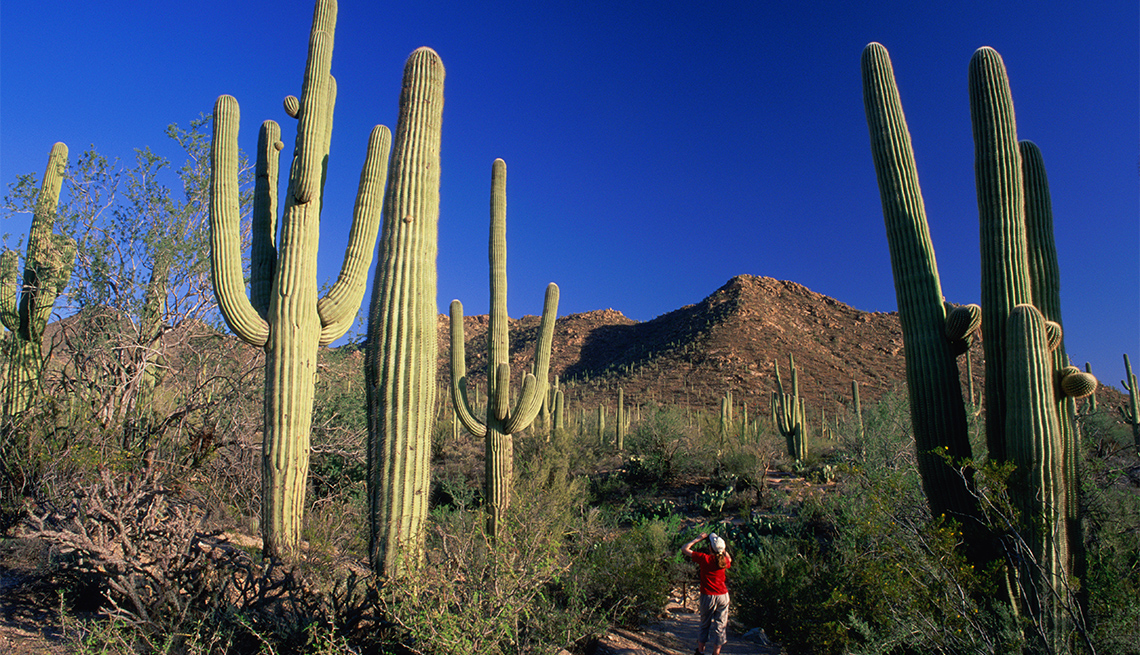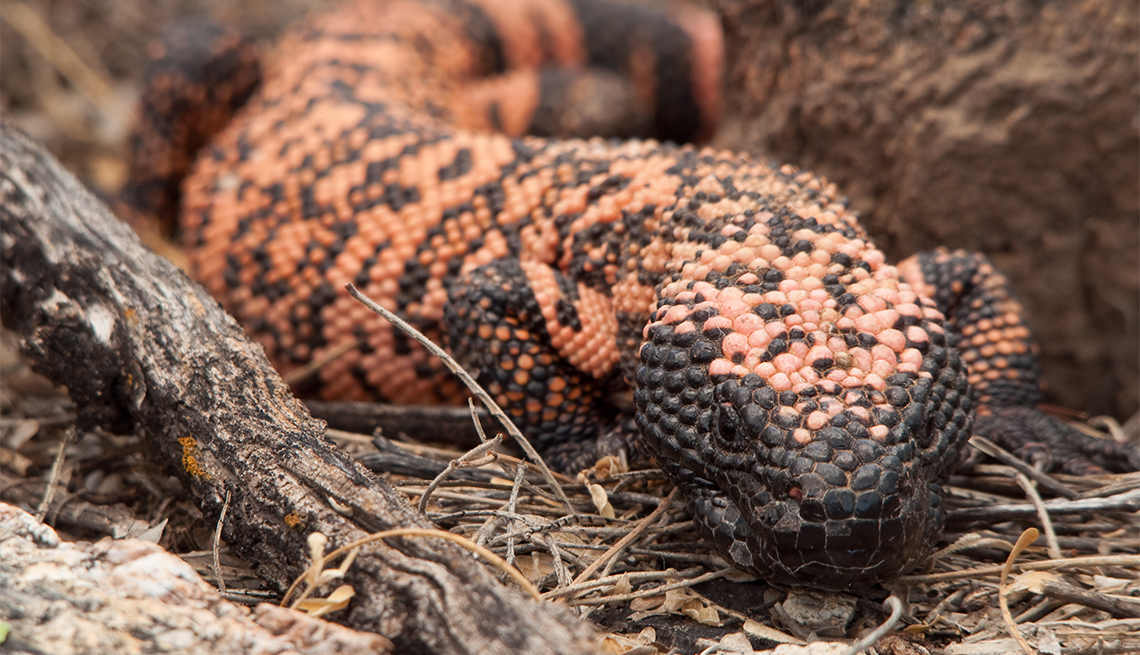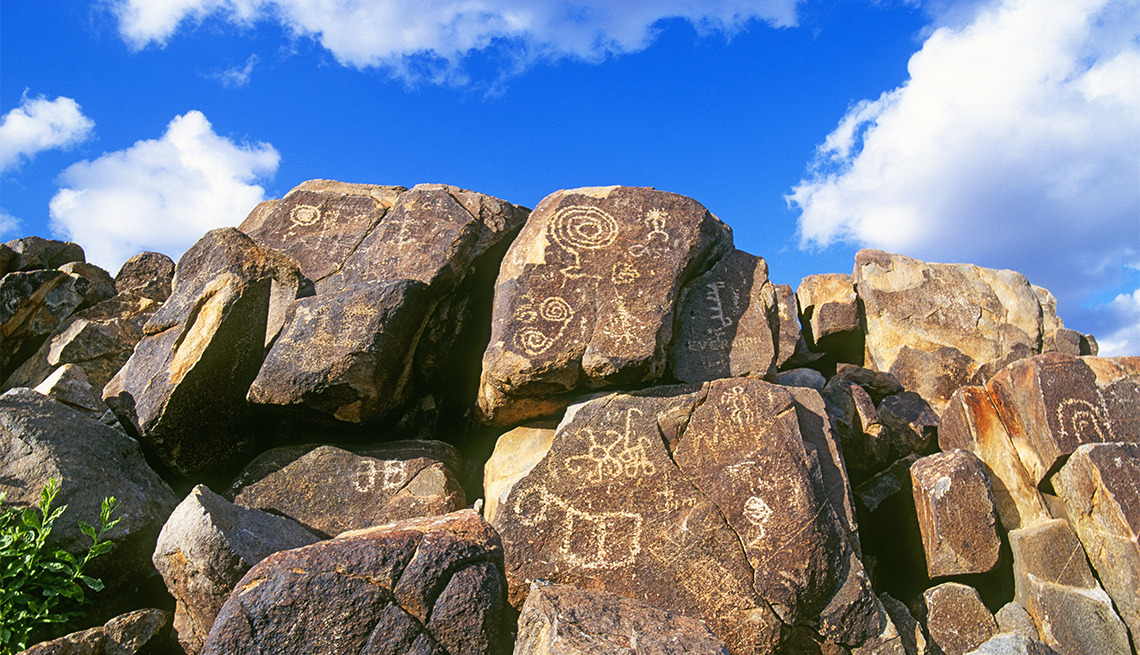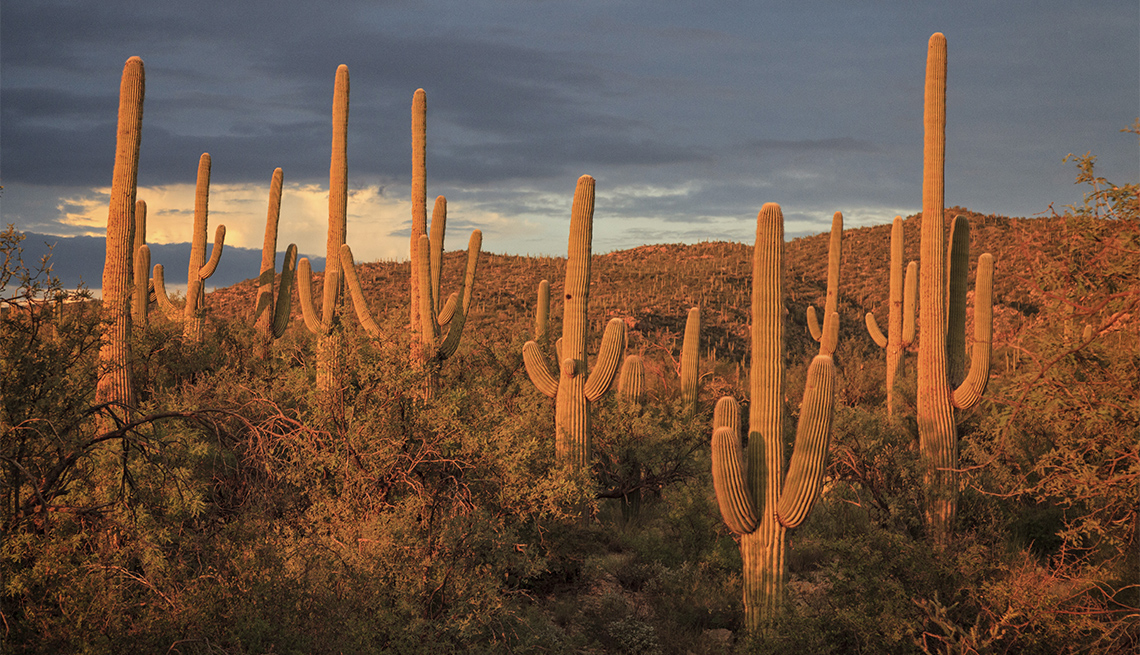AARP’s Guide to Saguaro National Park in Arizona
Iconic giant cacti are the stars in this photo-ready Southwestern desert preserve
A sea of towering columnar saguaro cacti stretches out before you like a brigade of soldiers guarding the desert landscape. Formidable with their spiny armor, it’s hard to imagine America’s largest cactus is the species that needs safeguarding. Found exclusively in the Sonoran Desert, this enduring symbol of the Southwest, which requires just the right amount of heat and moisture to survive, faces threats such as climate change and invasive species. The 91,327 acres that comprise Saguaro National Park (SNP) in southeast Arizona provide the perfect climate as well as protection for vast forests of saguaro (pronounced Sa-WAH-ro) cacti to thrive.
These desert monarchs can grow upwards of 60 feet tall, weigh more than two tons and live for two centuries. But while they’re certainly the park’s stars, they’re far from the only reason it attracts more than a million visitors annually. For one thing, there are 24 other cactus species, ranging from the fuzzy-looking teddy bear cholla to the pancake-shaped Engelmann’s prickly pear.
Despite the harsh desert environment, an abundance of flora and fauna flourish here, including such native species as the roadrunner, horned lizard, kangaroo rat and the prehistoric-looking Gila monster. At the park’s higher elevations, topping out at 8,666 feet, you’ll find oak woodland and pine forests that are home to black bears and the elusive coati, which resembles a raccoon.
SNP’s two distinct districts — the western Tucson Mountain District and the eastern Rincon Mountain District — are separated by the city of Tucson. The western district is lower in elevation, has denser patches of saguaro and is known for its iconic Southwest landscape. The eastern section, larger and more mountainous, contains six biotic zones and 6,000 plant species, and it’s second in biodiversity to the Amazon rain forest.
President Herbert Hoover established the area as a national monument in 1933, and during the Great Depression, the Civilian Conservation Corps laid the groundwork for tourism by building walking paths and installing picnic benches and visitor shelters. It wasn’t until 1994 that the area earned national park status. Today the park’s proximity to Tucson, combined with recently installed handicap-friendly amenities ranging from paved walking paths to picnic tables with overhanging ends for wheelchair access, makes it one of the nation’s most accessible national parks.
“Over the last few years, we’ve made sure there are opportunities for multigenerational and multi-ability groups to access more trails and picnic areas,” says park ranger Andy Fisher. “Our latest efforts, like the Mica View Trail, ensure these groups can do more than just stroll down a path. They can actually get out into the desert regardless of their physical ability.”
Location: Southeast ArizonaSize: 91,327 acresTrails: 192 milesElevation: 2,180 to 8,666 feet Main attraction: The iconic saguaro cactus
Entry fee: $25 for a weekly vehicle pass, including all passengers; $20 for an annual Senior Pass (62+)
Best way to see it: On foot or by bike along the Bajada Loop Drive or the Cactus Forest Loop
When to go to avoid the crowds: Winter
Handicap accessible: Yes
Plan Your Trip
Approximately 30 miles apart, SNP’s eastern and western districts hug Tucson, Arizona’s second-largest city, with a population of 541,482. From downtown, you can drive to either park entrance in 20 minutes. The western district gets twice as many visitors as the eastern district, thanks in large part to its proximity to the bucket-list Arizona-Sonora Desert Museum (see below), says Fisher.
Each district has its own visitors center, open from 9 a.m. to 5 p.m. daily. Both offer accessibility features including designated parking spaces, accessible restrooms and drinking fountains, paved paths and captioned orientation programs. Both also have bookstores, information centers and water filling stations. The National Park Service recommends drinking at least one gallon of water per day and, during hot summer months, at least one quart per hour when hiking. Be sure to have a hat, sunglasses, sunscreen and a pack with clothing layers, since it can get cold at higher elevations. Neither visitor center has Wi-Fi, and cellphone service is spotty throughout the park.
The Red Hills Visitor Center (also called the West District Visitor Center) hosts a daily educational program on the Native American perspective on the saguaro that’s well worth the time. The Rincon Mountain Visitor Center (the East District Visitor Center) serves as the starting point for the scenic Cactus Forest Loop Drive, an 8-mile, cacti-lined road that you can drive or bike. To reach the hiking trails from the visitor center, you must drive into the park on the Loop Drive. The first trailhead with parking is about 2 miles along the drive and begins at the Mica View Picnic Area.
The Bajada Loop Drive is the best way to explore the western district’s foothills, providing plenty of photo ops at pullouts and picnic areas, plus access to trailheads. Although the 6-mile loop is unpaved, you certainly don't need a four-wheel-drive vehicle. It begins at Hohokam Road, a mile and a half west of the visitor center.
The park has no concessions so pack a picnic lunch. Six picnic areas are accessible by vehicle — two in Saguaro East and four in Saguaro West — and each has a charcoal grill, a wheelchair-accessible pit toilet and paved ground surfaces.
SNP is open daily except for Christmas Day. Annual visitation would almost certainly be higher if the summer months weren’t unbearably hot, with triple-digit daytime temperatures. If you do visit in the summer, plan activities for early morning or the end of the day. This may be the desert, but June 15 through Sept. 30 is monsoon season, so expect severe afternoon thunderstorms and even flash floods. Cool temperatures ranging from the high 50s to the mid-70s make November to March prime time to visit. And in spring — specifically the last two weeks of April through the first week of June — the park is a photographer’s paradise, with cacti sprouting vivid blooms in hues of white, fuchsia and canary yellow. “June is my favorite time in the park,” says Fisher, the ranger. “The flowers are usually at their peak. It’s an amazing sight to see, but this isn’t the time of month to hike. Take in the blooms on a scenic drive.”
Where to Stay and Eat
You won’t find any lodging options in SNP, or even camping options in the park’s western section. To really experience the desert, reserve one of the eastern district’s six designated backcountry campsites ($8 a night), which can be accessed only on foot and require a base level of fitness to reach. Limited facilities include vault toilets. Water is unreliable, so you should pack your entire water supply for your trip, carry a filter, and check current water reports at the visitor center (520-733-5153).
Manning Camp, the home of former Tucson mayor Levin Manning that sits atop the Rincon Mountains, is a tough uphill day hike, but worth the effort. “This part of the park is a special treasure,” says Fisher. “To do this hike in a day takes a solid eight hours, but you go from seeing saguaro forest and Gila monster lizards to aspen groves and owls in one day. It’s a totally unique ecosystem up there.” You can take the Douglas Spring Trail or the Arizona Trail, both of which have campgrounds along the way if you prefer to break the trek up into two days. The original Manning cabin, built in 1905, now hosts trail crews and researchers, and from April through September, a ranger is stationed here. The six tent sites are nestled in a conifer forest at nearly 8,000 feet and temperatures rarely exceed 85 degrees — a welcome relief from the valley floor’s sweltering heat. A waterfall fed from a large pond makes this one of the rare sites with a reliable water source.
The amenity-rich Gilbert Ray Campground sits just outside the west entrance to the park, close to the Brown Mountain Loop trail. It features 130 RV sites ($20 per night) and five designated tent sites ($10 per night), plus picnic tables and modern restrooms with handicap accessibility.
Hotels ranging from luxury resorts to hip boutique properties are less than a 30-minute drive away in downtown Tucson. If you prefer to be closer to the trails, the park’s western side offers a handful of intimate inns close to the park entrance, including the three-room Casa Tierra Adobe Bed & Breakfast and the two-room Hacienda Linda. JTH Tucson, the western side’s newest and most stylish stay, is a 10-minute drive from such popular hikes as the Hugh Norris Trail. Rentable via Airbnb, the five-suite inn features Southwest adobe-style decor, a rooftop for stargazing and a communal firepit.
You won’t find dining options within the park, but Phoebe’s Coffee Bar and the Ocotillo Café, both within the Arizona-Sonora Desert Museum, located less than 2 miles from the West District Visitor Center, are excellent options for a snack or lunch. Stop at the Wagon Wheel Post, an old-timey general store 6 miles north of the west side visitor center, for beer, snacks and charcoal if you score a campsite with a grill.
Things to Do
Hike. With 192 miles of marked hiking trails, SNP offers treks for visitors of all abilities. No matter your fitness level, be sure to plan your hikes to avoid the midday desert heat, and pack plenty of water. And remember, those photogenic cacti are covered in spines, so keep to the trail to avoid getting pricked.
For an easy stroll that doubles as an intro to the desert ecosystem, try the quarter-mile Desert Ecology Trail along the Cactus Forest Drive in the East District or the half-mile Desert Discovery Trail off of Kinney Road in the west. Both paved trails include resting benches and interpretive exhibits on the park’s plants and animals.
The 0.7 mile Mica View Trail in the east, which begins at the Mica Picnic Area parking lot, was recently flattened and hardened to meet ADA standards and support wheelchairs. On this hike, you’ll likely glimpse Gila woodpeckers and gilded flickers in their saguaro nest holes, and you’ll take in views of Tanque Verde Peak and Mica Mountain.
If you want to challenge yourself, try the eastern district’s Tanque Verde Ridge Trail, by the Javelina Picnic Area off of the Cactus Loop Drive. The strenuous, 18-mile hike gains 4,750 feet of elevation and passes through all six of the area’s biotic zones.
On the west side, access the King Canyon trailhead outside of the park off of Kinney Road and zigzag up to the summit of 4,687-foot Wasson Peak, the highest point in the Tucson Mountain Range. Approximately 7 miles round trip, with 1,939 feet of elevation gain, this moderate hike passes rock walls carved with ancient petroglyphs and an old stone miner’s hut.
Bike. In this, one of the country’s most bike-friendly national parks, take your pick of four excellent scenic loops for road cyclists and mountain bikers. The popular and aptly named Cactus Forest Loop, next to the East District Visitor Center, runs for eight miles on a paved, rolling road that you’ll share with vehicles. On the park’s west side, the six-mile Bajada Loop Drive off of Kinney Road, a gravel path, passes a giant forest of saguaros.
Watch the sunset. The desert sunset may rival the saguaros as the park’s most Instagrammed natural wonder. As dusk falls, the setting sun turns a brilliant red that paints the sky in pinks and oranges worthy of a Monet painting. On the easy-to-access Desert Discovery Trail off of Kinney Road in the West District, catch sunset views through a forest of saguaros. On the east side, the Cactus Forest Loop Drive remains open until 8 p.m., giving you plenty of time to pull off and savor sunset at the Javelina Rocks Overlook, near the loop’s end.
Learn. Rangers typically lead four to six different daily talks and interpretive tours that explore topics including desert survival, the lifespan of a saguaro and misunderstood predators, such as the mountain lion. Both park visitor centers have cactus gardens with interpretive signs you can explore on your own or with a ranger. Both districts also co-host monthly stargazing nights with a local astronomy group. Participants must sign up in advance.
View petroglyphs. Most of SNP’s rock art dates back to the prehistoric Hohokam culture. Abstract designs, including spirals and squiggly lines as well as drawings of animals, humans and astrological objects, have been etched onto the surface of sandstone and other rocks throughout the park. The best place to view the petroglyphs is along the Signal Hill Trail, which starts at the Signal Hill picnic area off of Hohokam Road in the West District. Starting at the Signal Hill Picnic area, the 0.3-mile trail gently climbs to a hill with more than 200 petroglyphs believed to have been created between 550 and 1,550 years ago.
Gateway Towns
Tucson is flanked on either side by SNP’s western Tucson Mountain District and the eastern Rincon Mountain District, making it an ideal base for day trips. A dream destination for fit foodies, Tucson owns bragging rights to being one of America’s most bike-friendly cities as well as having America’s first and only UNESCO City of Gastronomy designation. On the Loop, a network of 131 miles of paved bicycle paths, you can access SNP as well as a plethora of other parks, shops and restaurants on two wheels. Transit Cycles and Bicycle Ranch are the city’s go-to bike shops.
For a hearty breakfast before hitting the park, head to Prep & Pastry’s east side location on Grant Avenue and order the oven-roasted sweet potato hash and breakfast sandwich with avocado. After working up an appetite biking or hiking in the park, reward yourself with a prickly pear mojito and a braised lamb tostada at Downtown Kitchen + Cocktails, run by James Beard Award-winning chef Janos Wilder. Head to Penca, an upscale Mexican eatery in the heart of downtown, for the best happy hour in town: two tacos for $5 and $5 sangria.
Two not-to-miss, open-air shopping centers anchor downtown’s hip Mercado District on the west end of the city’s modern streetcar line: Mercado San Agustín and the MSA Annex. At the latter, a collection of 10 indie businesses housed in repurposed shipping containers, pick up nostalgic SNP-inspired gear at Why I Love Where I Live and home goods crafted by local artisans at Mesa. Wellness enthusiasts who prefer to end long days of hiking with massages and healthy meals splurge on stays at Canyon Ranch, in the northeast mountain foothills of Tucson. A less pricey alternative in northeast Tucson is Hacienda del Sol Guest Ranch Resort, which pampers guests with a three-room spa and elegant Spanish Colonial casitas. To be within walking distance of downtown’s shops and restaurants, opt for the retro Downtown Clifton Hotel. Locals favor its restaurant, the Red Light Lounge, for its selection of Arizona craft brews.
The burgeoning town of Marana, an alternate gateway to the West District, is located about 15 miles north of the visitor center. Don’t miss the pork carnitas at La Olla Mexican Café, and stop by Catalina Brewing Co. to try craft ales brewed with local ingredients, such as prickly pear fruit and mesquite flour. The town’s main draw, the Ritz Carlton Dove Mountain luxury resort, delivers five-star service and get highs marks for its restaurants and golf course.
AARP Membership -Join AARP for just $12 for your first year when you enroll in automatic renewal
Join today and save 25% off the standard annual rate. Get instant access to discounts, programs, services, and the information you need to benefit every area of your life.
En Route
Located down the road from the West District Visitor Center, the Arizona–Sonora Desert Museum ranks as the state’s second-most-visited attraction, behind only the world-famous Grand Canyon. Part natural history museum, part desert botanical garden and part zoo, this 98-acre, indoor-outdoor attraction showcases more than 55,000 plants from 1,200 native species along 2 miles of gravel and paved trails. View native animals such as coyotes, raptors, hummingbirds, ocelots and piglike javelinas in re-created habitats. Learn about the area’s geology in the Earth Sciences Center and view nature-inspired exhibits throughout the year at two on-site art galleries.
Geology fans detour to 2,400-acre Colossal Cave Mountain Park, a 15-minute drive southeast of Tucson in the community of Vail, to explore its extensive underground cave network. One of North America’s largest dry caves, it took more than two years to map the 2 miles of passageways open to visitors. Guided tours, which range from 40 minutes to 3.5 hours, require a decent fitness level, as you’ll be descending 350-plus stairs, scrambling down ladders, and crossing rock bridges to view stalactites and stalagmites sculpted over the course of millions of years. Back above ground, you can mount a horse at the park’s La Posta Quemada Ranch for a guided trail ride.
If you’re a fan of art and history, visit the village of Tubac, 40 miles south of Tucson. Established in 1752 as a Spanish presidio, Tubac has emerged as a destination for artists, with top-notch galleries and studios. For tasteful souvenirs, this is your one-stop shop for turquoise and silver jewelry, Navajo blankets and mesquite furnishings. Tumacácori National Historical Park, less than a 10-minute drive from the village, explores the region’s Spanish colonial past. The expansive grounds include a museum, the ruins of three Spanish mission communities and the state’s second-oldest church.
- |
- Photos
Jen Murphy is a columnist at The Wall Street Journal and a regular contributor to Travel + Leisure, Outside and Departures. She is the editor of Wildsam Field Guides: Hawaii.

